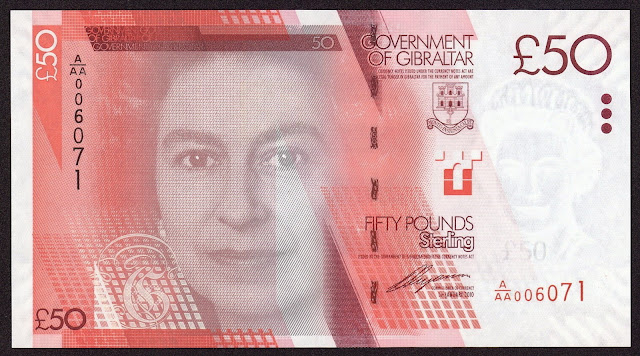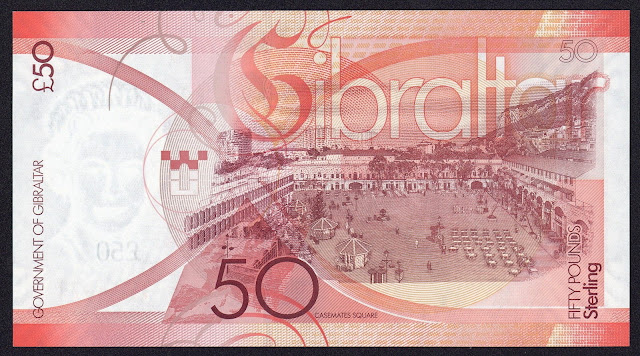Gibraltar Banknotes 50 Pounds banknote 2010 Queen Elizabeth II
Issued by The Government of Gibraltar
Obverse: Portrait of Her Majesty Queen Elizabeth II and Capital letter "G". Coat of arms of Gibraltar at right. Dated Dated 1 January 2010. Signature of Dilip Dayaram Tirathdas (as Commissioner of Currency). Windowed security thread with demetalized text on front. One horizontal and one vertical 6-digit serial number (both with nurmerals of ascending size) with fractional prefix.
Reverse: Buildings surrounding the Grand Casemates Square (originally part of the Lower Ward of the Moorish Castle now a gastronomic, shopping and leisure hub)
Casemates Square was the heart of La Barcina, part of the 15th century Spanish City, at the confluence of the roads leading to the land and sea gates to Gibraltar. The British built large barracks at this strategic point, Casemates Barracks, that gave the square its present name.
Original size: 155 x 85 mm.
Printer: Thomas De La Rue & Company Limited, London England.
Portrait of Queen Elizabeth II and electrotype £50 and cornerstones as watermark.
Gibraltar banknotes - Gibraltar paper money
2010-2011 Issue
Grand Casemates Square in Gibraltar
Grand Casemates Square (colloquially Casemates Square or Casemates) is the largest of the two main squares within the city centre of Gibraltar (the other being John Mackintosh Square). The square takes its name from the British-built Grand Casemates, a casemate and bombproof barracks at the northern end of the square completed in 1817.
Located at the northern end of Main Street, the square is lined with numerous pubs, bars and restaurants and acts as the gateway into Gibraltar's city centre for most tourists.
Moorish period
Grand Casemates Square dates back to Gibraltar's Moorish period when the place was first fortified, making it as old as the city itself.
The square is built on sand that was once a beach. In May 1160 Moroccans sent by the Almohad ruler Abd al-Mu'min landed to lay the foundations of the first substantial settlement. This "City of Victory" (Medinat al-Fath) was small and included the area within the Moorish Castle and the land just below. It was this new ruler who changed the name of the rock to Jabal al-Fath meaning Mount of Conquest.
This land was an intertidal zone used by the Muslims to beach their galleys. After the Siege of Gibraltar in 1309, Ferdinand IV of Castile gave orders that a galley house be built where his ships could be repaired. This house gradually sank into the sand over the next few centuries.
Spanish period
In the late 15th century a gate in the wall near Water Gate was opened to let galleys in. The building of the Old Mole in the 1570s led to the passage silting and the galley house became unusable.
The area of Grand Casemates Square formed part of the old town Spanish: Villa Vieja during Spanish times, being walled with its own gates and towers. Early 17th century plans refer to this area as La Barcina.
British period
Following the problems the Spanish faced with the buildings sinking into the soft wet ground, the British begun to construct fortress walls and battlements on higher, more solid ground. In 1770, chief engineer William Green began preparatory work for the construction of Grand Casemates as bombproof barracks on the square's northern flank. However, its construction was not started until after the Great Siege of 1779-1783 and it was finished in 1817 under the governorship of General Sir George Don.
After the Great Siege the British decided to demolish most buildings within the square which had suffered great damage. This opened up the area into an esplanade which could be used for public events such military parades and public executions.
Capital punishment in Gibraltar: Grand Casemates Square was once the site of public military hangings, with the last one been held in 1864.
21st century
Nowadays Grand Casemates Square has become a commercial hub housing numerous pubs, bars, restaurants and shops following the refurbshment of the square in the 1990s to replace a car park which occupied half the square. The square is also used to host various cultural events from live open-air concerts, to National Day celebrations. In 2012 the square was host to celebration for Elizabeth II's Diamond Jubilee celebration which was attended by the Earl and Countess of Wessex.

